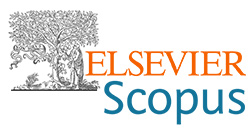Decreasing of water absorptiveness of paper by coating nanofibrillated cellulose films
DOI:
https://doi.org/10.5937/zasmat2103180MAbstract
Nanofibrillated films based on TEMPO-oxidized cotton linters were applied to reduce the hydrophilic properties of paper. For this purpose, aqueous dispersions of nanofibrillated cellulose of different composition: 1 and 3% of nanofibrillated cellulose, up to 13% of CaCO3 and/or Al(OH)3, up to 20% of propane-1,2-diol (glycol), and up to 21% of TEMPO-oxidized cotton linters were coated on the model paper, without additional adhesive. The pristine model paper and papers coated with nanofibrillated cellulose-based composite films were characterized in terms of water absorptiveness by COBB method and water drop contact angle measurements. The surface appearance was characterized by scanning electron microscopy (SEM) and surface chemistry by infrared spectroscopy with Fourier transform and attenuated total reflection (ATR-FTIR). Additionally, optical properties, i.e. measurement of reflection curves and CIE degrees of whiteness, were determined according to appropriate standards. For all papers coated with nanofibrillated cellulose-based films, depending on the composition of the dispersions, a decrease in sorption properties was achieved, without changes in optical properties and surface morphology of the paper compared to the pristine paper.Keywords:
nanofibrillated cellulose films, TEMPO-oxidized cellulose, paper, water absorptiveness, contact angle, optical properties, surface morphologyReferences
Banik, G., Brückle, I. (2011) Paper and Water: A Guide for Conservators Principle. Oxford: Elsevier Publishers
Brodin, F.W., Gregersen, Ø.W., Syverud, K. (2014) Cellulose nanofibrils: Challenges and possibilities as a paper additive or coating material: A review.Nordic Pulp and Paper Research Journal, 29(1): 156-166
https://doi.org/10.3183/npprj-2014-29-01-p156-166
Camargos, C.H.M., Figueiredo, J.C.D., Pereira, F.V. (2016) Nanocellulose for conservation and restoration of graphic documents: Experimental evidence. pp.14
Camargos, C.H.M., Figueiredo, J.C.D., Pereira, F.V. (2017) Cellulose nanocrystal-based composite for restoration of lacunae on damaged documents and artworks on paper.Journal of Cultural Heritage, 23: 170-175
https://doi.org/10.1016/j.culher.2016.10.007
Carter, H.A. (1996) The Chemistry of Paper Preservation: The Strengthening of Paper.Journal of Chemical Education, Part 3, 73(12): 1160-1167
https://doi.org/10.1021/ed073p1160
Castro, K., Pérez, M., Rodríguez-Laso, M.D., Madariaga, J.M. (2003) Peer Reviewed: FTIR Spectra Database of Inorganic Art Materials.Analytical Chemistry, 75(9): 214-221
https://doi.org/10.1021/ac031320e
Chang, P.S., Robyt, J.F. (1996) Oxidation of Primary Alcohol Groups of Naturally Occurring Polysaccharides with 2,2,6,6-Tetramethyl-1-Piperidine Oxoammonium Ion.Journal of Carbohydrate Chemistry, 15(7): 819-830
https://doi.org/10.1080/07328309608005694
Choukri, T., Michel, V. (2000) TEMPO-oxidation of cellulose: Synthesis andcharacterisation of polyglucuronans.Cellulose, 7: 177-188
https://doi.org/10.1023/A:1009276009711
Chung, C., Lee, M., Choe, E. (2004) Characterization of cotton fabric scouring by FT-IR ATR spectroscopy.Carbohydrate Polymers, 58(4): 417-420
https://doi.org/10.1016/j.carbpol.2004.08.005
de Nooy, A.E.J., Besemer, A.C., van Bekkum, H. (2010) Highly selective tempo mediated oxidation of primary alcohol groups in polysaccharides.Recueil des Travaux Chimiques des Pays-Bas, 113(3): 165-166
https://doi.org/10.1002/recl.19941130307
Eichhorn, S.J., et al. (2010) Review: Current international research into cellulose nanofibres and nanocomposites.Journal of Materials Science, 45(1): 1-33
https://doi.org/10.1007/s10853-009-3874-0
Hassan, A.E., Hassan, L.M., Oksman, K. (2011) Improving bagasse pulp paper sheet properties with microfibrilated cellulose isolated xylanase-treated bagasse.Wood Fiber Science, 42: 979-982
He, M., Cho, B., Won, J.M. (2016) Effect of precipitated calcium carbonate-Cellulose nanofibrils composite filler on paper properties.Carbohydrate Polymers, 136: 820-825
https://doi.org/10.1016/j.carbpol.2015.09.069
Honorato, C., Kumar, V., Liu, J., Koivula, H., Xu, C., Toivakka, M. (2015) Transparent nanocellulose-pigment composite films.Journal of Materials Science, 50 (22): 7343-7352
https://doi.org/10.1007/s10853-015-9291-7
Hospodarova, V., Singovszka, E., Stevulova, N. (2018) Characterization of Cellulosic Fibers by FTIR Spectroscopy for Their Further Implementation to Building Materials.American Journal of Analytical Chemistry, 9(6): 303-310
https://doi.org/10.4236/ajac.2018.96023
Isogai, A., Saito, T., Fukuzumi, H. (2011) TEMPO oxidized cellulose nanofibers.Nanoscale, 3(1): 71-85
https://doi.org/10.1039/C0NR00583E
Jiang, F., Yang, Y., Weng, J., Zhang, X. (2016) Layer-by-Layer Self-Assembly for Reinforcement of Aged Papers.Industrial and Engineering Chemistry Research, 55(40): 10544
https://doi.org/10.1021/acs.iecr.6b02988
Jin, L., Yanwei, W., Qinghua, X., Wenrun, Y., Zhengliang, C. (2014) Cellulose nanofibers prepared from TEMPO-oxidation of kraft pulp and its flocculation effect on kaolin clay.Journal of Applied Polymer Science, 131(12): 40450
https://doi.org/10.1002/app.40450
Jin, Y., Edler, K.J., Marken, F., Scott, J.L. (2014) Voltammetric optimisation of TEMPO-mediated oxidations at cellulose fabric.Green Chemistry, 16(6): 3322-3327
https://doi.org/10.1039/C4GC00306C
Kajanto, I., Kosonen, M. (2012) The potential use of micro and nano fibrillated cellulose as a reinforcing element in paper and board based packaging. in: TAPPI International Conference on nanotechnology for renewable materials, 2(6): 42-48
Korica, M., et al. (2018) Novel protein-repellent and antimicrobial polysaccharide multilayer thin films.Holzforschung, 73(1): 93-103
https://doi.org/10.1515/hf-2018-0094
Li, B., et al. (2015) Cellulose nanocrystals prepared via formic acid hydrolysis followed by TEMPO-mediated oxidation.Carbohydrate Polymers, 133. 605-612
https://doi.org/10.1016/j.carbpol.2015.07.033
Milanović, J., Lazić, T., Živković, I., Vuksanović, M., Milošević, M., Kostić, M. (2020) The Effect of Nanofibrillated Tempo-oxidized Cotton Linters on the Strength and Optical Properties of Paper.Journal of Natural Fibers, Published online: 24 December 2020
Milanović, J.Z., Milanović, P., Kragić, R., Kostić, M. (2018) 'Do-It-Yourself' reliable pH-stat device by using open-source software, inexpensive hardware and available laboratory equipment.PLOS ONE, 13(3): e0193744
https://doi.org/10.1371/journal.pone.0193744
Pereira, V.F. (2016) Nanocellulose-based composites for conservation and restoration of cultural heritage on paper: Comparative studies between traditional and innovative methods. in: TAPPI international conference on nanotechnology for renewable materials, Conference paper, 348-365
Praskalo, J., Kostić, M., Potthast, A., Popov, G., Pejić, B., Škundrić, P. (2009) Sorption properties of TEMPO-oxidized natural and man-made cellulose fibers.Carbohydrate Polymers, 77(4): 791-798
https://doi.org/10.1016/j.carbpol.2009.02.028
Qinghua, X., Weigong, L., Zhengliang, C., Gao, Y., Menghua, Q. (2014) TEMPO/NaBr/NaClO-Mediated Surface Oxidation of Nanocrystalline Cellulose and Its Microparticulate RetentionSystem with Cationic Polyacrylamide.BioResources, 9(1): 994-1006
https://doi.org/10.15376/biores.9.1.994-1006
Saito, T., Shibata, I., Isogai, A., Suguri, N., Sumikawa, N. (2005) Distribution of carboxylate groups introduced into cotton linters by the TEMPO-mediated oxidation.Carbohydrate Polymers, 61(4): 414-419
https://doi.org/10.1016/j.carbpol.2005.05.014
Saito, T., Isogai, A. (2004) TEMPO-mediated oxidation of native cellulose: The effect of oxidation conditions on chemical and crystal structures of the water-insoluble fractions.Biomacromolecules, 5(5): 1983-1989
https://doi.org/10.1021/bm0497769
Shen, J., Song, Z., Qian, X., Yang, F. (2010) Carboxymethyl cellulose/alum modified precipitated calcium carbonate fillers: Preparation and their use in papermaking.Carbohydrate Polymers, 81(3): 545-553
https://doi.org/10.1016/j.carbpol.2010.03.012
Stadler, A., Sage, D. D.Shape: Analysis. http://bigwww.epfl.ch/demo/dropanalysis/, 01.03.2021
Stalder, A.F., Melchior, T., Müller, M., Sage, D., Blu, T., Unser, M. (2010) Low-bond axisymmetric drop shape analysis for surface tension and contact angle measurements of sessile drops.Colloids and Surfaces A: Physicochemical and Engineering Aspects, 364(1-3): 72-81
https://doi.org/10.1016/j.colsurfa.2010.04.040
Taipale, T., Österberg, M., Nykänen, A., Ruokolainen, J., Laine, J. (2010) Effect of microfibrillated cellulose and fines on the drainage of kraft pulp suspension and paper strength.Cellulose, 17(5): 1005-1020
https://doi.org/10.1007/s10570-010-9431-9
Vohrer, U., Trick, I., Bernhardt, J., Oehr, C., Brunner, H. (2001) Plasma treatment: An increasing technology for paper restoration?.Surface and Coatings Technology, 142-144: 1069-1073
https://doi.org/10.1016/S0257-8972(01)01280-4
Völkel, L., Ahn, K., Hähner, U., Gindl-Altmutter, W., Potthast, A. (2017) Nano meets the sheet: Adhesive-free application of nanocellulosic suspensions in paper conservation.Heritage Science, 5(1): 23-30
https://doi.org/10.1186/s40494-017-0134-5
Yuan, B., et al. (2016) Transparent and flame retardant cellulose/aluminum hydroxide nanocomposite aerogels.Science China Chemistry, 59(10): 1335-1341
Downloads
Published
Issue
Section
License
Copyright (c) 2021 CC BY 4.0 by Authors

This work is licensed under a Creative Commons Attribution 4.0 International License.






